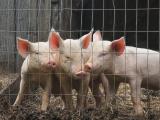Jun 2, 2010
Group notes 6 challenges for next pandemic
An international committee released six public health policy challenges that it anticipates will continue for the next 12 to 18 months and will help shape and improve preparation for the next pandemic: measuring age-specific immunity to infection, accurately quantifying severity, improving treatment outcomes for severe cases, quantifying the effectiveness of interventions, capturing the full impact of the pandemic on mortality, and rapidly identifying and responding to antigenic variants.
http://www.plosmedicine.org/article/info%3Adoi%2F10.1371%2Fjournal.pmed.1000275
Jun 1 PloS Med commentary
H1N1 in skunks suggests wildlife transmission
In perhaps the first documented pandemic H1N1 infection in wild animals, researchers from British Columbia confirmed the virus in two skunks found dead at a mink farm, they reported in Emerging Infectious Diseases. Some minks had respiratory symptoms, but no testing was done. Farm workers did not report flu-like illness but could have had asymptomatic infections. Researchers said skunks could play a role in interspecies transmission and should be included in wildlife flu surveillance.
http://dx.doi.org/10.3201/eid1606.100352
June Emerg Infect Dis letter
Test for H1N1, H5N1 could aid early diagnosis
Researchers from Beijing developed a real-time polymerase chain reaction assay that can simultaneously detect pandemic H1N1 flu and H5N1 avian flu. In a Virology Journal report today, they said early symptoms for both influenzas are similar, and a test to detect both could be useful for diagnosis and surveillance. In tests on 236 clinical specimens, they found the duplex test was as sensitive as each single-target test, and was even more sensitive for H5N1.
http://dx.doi.org/10.1186/1743-422X-7-113
Jun 2 Virol J study
Ontario notes pluses, minuses of H1N1 response
Ontario's chief medical officer reported today that the province responded well to pandemic flu but could benefit from better coordination to ensure services to all. Successes included getting vaccine to all who wanted it, reaching isolated villages, and collaboration between levels of government. Areas for improvement include better information on vaccine from the federal government, greater preparedness for mass immunization, and an ability to electronically track vaccine shipments and uptake.
http://news.ontario.ca/mohltc/en/2010/06/ontario-responded-well-to-h1n1-pandemic-says-chief-medical-officer-of-health.html
Jun 2 Ontario Ministry of Health release
Melbourne attack rate lower than expected
Researchers who tested blood samples from 706 Melbourne residents from August to October found that 16% had antibodies to pandemic H1N1 flu. Assuming an estimated 6% prevalence rate of antibodies existing before the pandemic, they estimated a pandemic flu attack rate of 10% in adults. The authors concluded, "This community attack rate is lower than anticipated," and said the results underscore the importance of vaccination.
http://dx.doi.org/10.1111/j.1753-6405.2010.00518.x
Jun 1 Aust NZ J Public Health abstract


















